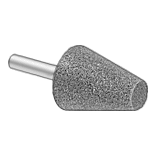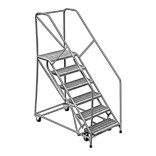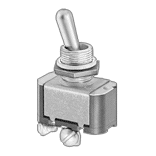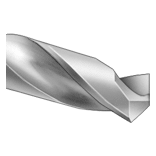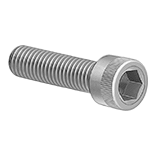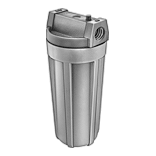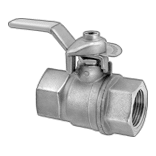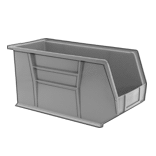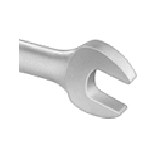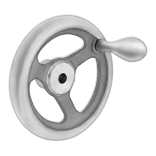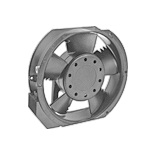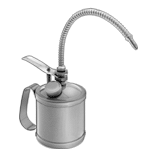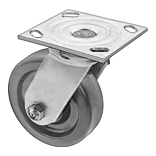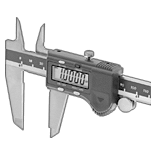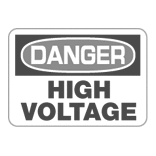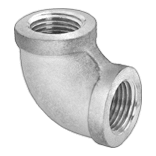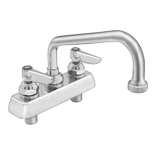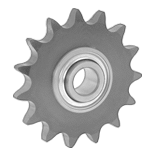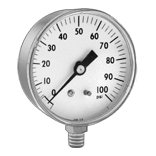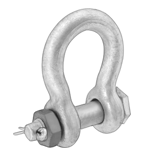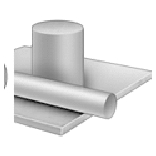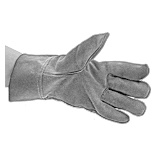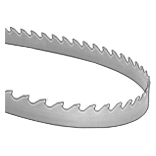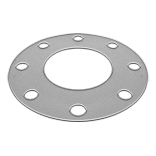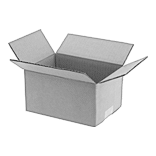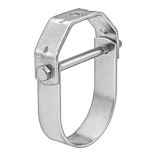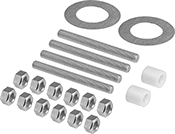Filter by
Maximum Flow
Flow Measurement Unit
Minimum Flow
Measures
Body Material
Wetted Parts Material
Fitting Connection
Flow Measurement Type
Maximum Pressure @ Temperature
Input Voltage
Measurement Unit
Fitting Material
Export Control Classification Number (ECCN)
DFARS Specialty Metals
Circuit Protection
Flow Transmitters with Sight
 |
Send flow rate data using these transmitters while also being able to visually confirm liquid is flowing. They measure flow by counting how many times the turbine turns as the liquid moves through it. To prevent clogging the turbine and other damage, use them only with clean, low-viscosity liquids. These transmitters, also known as transducers, convert the flow measurement to an electrical signal that can be interpreted by receiving devices, such as remote displays and programmable logic controllers (PLCs), to monitor flow or control equipment. Mount them directly inline with your system. They measure accurately in any mounting orientation.
These transmitters are calibrated with water. You can use them with other liquids, but they may not measure accurately if the liquid’s viscosity differs from water.
Analog Transmitter Output—Transmitters with an analog output increase their output signal as flow increases. For your receiving device to interpret the signal, you will need to calibrate it for the measurement range and output signal of the transmitter. They only give accurate readings within the rated measurement range.
Digital Pulse Output—Transmitters with a digital pulse output send flow data using spikes of voltage that match the input voltage of the transmitter. The higher the flow, the more pulses they send.
Flow Measurement Type | Pipe Connections | Flow Range, gpm | End-to-End Lg. | Accuracy | Max. Pressure @ Temp. | Temp. Range, ° F | Seal Material | Input Voltage Range, V DC | Mounting Position | Field Recalibratable | Pulse Freq., Hz | Pulse Frequency per Volume, pulse per gal. | Each | ||||||||||||||||||||||||||||||||||||||||||||||||||||||||||||||||||||||||||||||||||||||
|---|---|---|---|---|---|---|---|---|---|---|---|---|---|---|---|---|---|---|---|---|---|---|---|---|---|---|---|---|---|---|---|---|---|---|---|---|---|---|---|---|---|---|---|---|---|---|---|---|---|---|---|---|---|---|---|---|---|---|---|---|---|---|---|---|---|---|---|---|---|---|---|---|---|---|---|---|---|---|---|---|---|---|---|---|---|---|---|---|---|---|---|---|---|---|---|---|---|---|---|
One 4-20 mA Analog Transmitter Output—Wire Lead Connection | |||||||||||||||||||||||||||||||||||||||||||||||||||||||||||||||||||||||||||||||||||||||||||||||||||
Glass-Filled Polypropylene Body with Glass-Filled Polypropylene Fitting | |||||||||||||||||||||||||||||||||||||||||||||||||||||||||||||||||||||||||||||||||||||||||||||||||||
| Turbine | 1/2 NPT Female | 0.25 to 2.5 | 3 11/16" | -2% to 2% | 150 psi @ 70° F | 20 to 150 | Buna-N | 12 to 24 | Any Angle | No | — | — | 00000000 | 0000000 | |||||||||||||||||||||||||||||||||||||||||||||||||||||||||||||||||||||||||||||||||||||
| Turbine | 1/2 NPT Female | 0.5 to 5 | 3 11/16" | -2% to 2% | 150 psi @ 70° F | 20 to 150 | Buna-N | 12 to 24 | Any Angle | No | — | — | 00000000 | 000000 | |||||||||||||||||||||||||||||||||||||||||||||||||||||||||||||||||||||||||||||||||||||
| Turbine | 1/2 NPT Female | 1.5 to 15 | 3 11/16" | -2% to 2% | 150 psi @ 70° F | 20 to 150 | Buna-N | 12 to 24 | Any Angle | No | — | — | 00000000 | 000000 | |||||||||||||||||||||||||||||||||||||||||||||||||||||||||||||||||||||||||||||||||||||
316 Stainless Steel Body with 316 Stainless Steel Fitting | |||||||||||||||||||||||||||||||||||||||||||||||||||||||||||||||||||||||||||||||||||||||||||||||||||
| Turbine | 1/2 NPT Female | 0.25 to 2.5 | 3 11/16" | -2% to 2% | 200 psi @ 70° F | 20 to 212 | Buna-N | 12 to 24 | Any Angle | No | — | — | 00000000 | 00000000 | |||||||||||||||||||||||||||||||||||||||||||||||||||||||||||||||||||||||||||||||||||||
| Turbine | 1/2 NPT Female | 0.5 to 5 | 3 11/16" | -2% to 2% | 200 psi @ 70° F | 20 to 212 | Buna-N | 12 to 24 | Any Angle | No | — | — | 00000000 | 00000000 | |||||||||||||||||||||||||||||||||||||||||||||||||||||||||||||||||||||||||||||||||||||
| Turbine | 1/2 NPT Female | 1.5 to 15 | 3 11/16" | -2% to 2% | 200 psi @ 70° F | 20 to 212 | Buna-N | 12 to 24 | Any Angle | No | — | — | 00000000 | 00000000 | |||||||||||||||||||||||||||||||||||||||||||||||||||||||||||||||||||||||||||||||||||||
| Turbine | 3/4 NPT Female | 1.5 to 15 | 5 1/4" | -2% to 2% | 200 psi @ 70° F | 20 to 212 | Buna-N | 12 to 24 | Any Angle | No | — | — | 00000000 | 00000000 | |||||||||||||||||||||||||||||||||||||||||||||||||||||||||||||||||||||||||||||||||||||
| Turbine | 3/4 NPT Female | 5 to 50 | 5 1/4" | -2% to 2% | 200 psi @ 70° F | 20 to 212 | Buna-N | 12 to 24 | Any Angle | No | — | — | 00000000 | 00000000 | |||||||||||||||||||||||||||||||||||||||||||||||||||||||||||||||||||||||||||||||||||||
| Turbine | 1 NPT Female | 1.5 to 15 | 5 1/4" | -2% to 2% | 200 psi @ 70° F | 20 to 212 | Buna-N | 12 to 24 | Any Angle | No | — | — | 00000000 | 00000000 | |||||||||||||||||||||||||||||||||||||||||||||||||||||||||||||||||||||||||||||||||||||
| Turbine | 1 NPT Female | 5 to 50 | 5 1/4" | -2% to 2% | 200 psi @ 70° F | 20 to 212 | Buna-N | 12 to 24 | Any Angle | No | — | — | 00000000 | 00000000 | |||||||||||||||||||||||||||||||||||||||||||||||||||||||||||||||||||||||||||||||||||||
One 0-5V DC Analog Transmitter Output—Wire Lead Connection | |||||||||||||||||||||||||||||||||||||||||||||||||||||||||||||||||||||||||||||||||||||||||||||||||||
Glass-Filled Polypropylene Body with Glass-Filled Polypropylene Fitting | |||||||||||||||||||||||||||||||||||||||||||||||||||||||||||||||||||||||||||||||||||||||||||||||||||
| Turbine | 1/2 NPT Female | 0.25 to 2.5 | 3 11/16" | -2% to 2% | 150 psi @ 70° F | 20 to 150 | Buna-N | 12 to 24 | Any Angle | No | — | — | 00000000 | 000000 | |||||||||||||||||||||||||||||||||||||||||||||||||||||||||||||||||||||||||||||||||||||
| Turbine | 1/2 NPT Female | 0.5 to 5 | 3 11/16" | -2% to 2% | 150 psi @ 70° F | 20 to 150 | Buna-N | 12 to 24 | Any Angle | No | — | — | 00000000 | 000000 | |||||||||||||||||||||||||||||||||||||||||||||||||||||||||||||||||||||||||||||||||||||
| Turbine | 1/2 NPT Female | 1.5 to 15 | 3 11/16" | -2% to 2% | 150 psi @ 70° F | 20 to 150 | Buna-N | 12 to 24 | Any Angle | No | — | — | 00000000 | 000000 | |||||||||||||||||||||||||||||||||||||||||||||||||||||||||||||||||||||||||||||||||||||
316 Stainless Steel Body with 316 Stainless Steel Fitting | |||||||||||||||||||||||||||||||||||||||||||||||||||||||||||||||||||||||||||||||||||||||||||||||||||
| Turbine | 1/2 NPT Female | 0.25 to 2.5 | 3 11/16" | -2% to 2% | 200 psi @ 70° F | 20 to 212 | Buna-N | 12 to 24 | Any Angle | No | — | — | 00000000 | 000000 | |||||||||||||||||||||||||||||||||||||||||||||||||||||||||||||||||||||||||||||||||||||
| Turbine | 1/2 NPT Female | 0.5 to 5 | 3 11/16" | -2% to 2% | 200 psi @ 70° F | 20 to 212 | Buna-N | 12 to 24 | Any Angle | No | — | — | 00000000 | 000000 | |||||||||||||||||||||||||||||||||||||||||||||||||||||||||||||||||||||||||||||||||||||
| Turbine | 1/2 NPT Female | 1.5 to 15 | 3 11/16" | -2% to 2% | 200 psi @ 70° F | 20 to 212 | Buna-N | 12 to 24 | Any Angle | No | — | — | 00000000 | 000000 | |||||||||||||||||||||||||||||||||||||||||||||||||||||||||||||||||||||||||||||||||||||
| Turbine | 3/4 NPT Female | 1.5 to 15 | 5 1/4" | -2% to 2% | 200 psi @ 70° F | 20 to 212 | Buna-N | 12 to 24 | Any Angle | No | — | — | 00000000 | 00000000 | |||||||||||||||||||||||||||||||||||||||||||||||||||||||||||||||||||||||||||||||||||||
| Turbine | 3/4 NPT Female | 5 to 50 | 5 1/4" | -2% to 2% | 200 psi @ 70° F | 20 to 212 | Buna-N | 12 to 24 | Any Angle | No | — | — | 00000000 | 00000000 | |||||||||||||||||||||||||||||||||||||||||||||||||||||||||||||||||||||||||||||||||||||
| Turbine | 1 NPT Female | 1.5 to 15 | 5 1/4" | -2% to 2% | 200 psi @ 70° F | 20 to 212 | Buna-N | 12 to 24 | Any Angle | No | — | — | 00000000 | 00000000 | |||||||||||||||||||||||||||||||||||||||||||||||||||||||||||||||||||||||||||||||||||||
| Turbine | 1 NPT Female | 5 to 50 | 5 1/4" | -2% to 2% | 200 psi @ 70° F | 20 to 212 | Buna-N | 12 to 24 | Any Angle | No | — | — | 00000000 | 00000000 | |||||||||||||||||||||||||||||||||||||||||||||||||||||||||||||||||||||||||||||||||||||
One Digital Pulse Output—Wire Lead Connection | |||||||||||||||||||||||||||||||||||||||||||||||||||||||||||||||||||||||||||||||||||||||||||||||||||
Polypropylene Body with Polypropylene Fitting | |||||||||||||||||||||||||||||||||||||||||||||||||||||||||||||||||||||||||||||||||||||||||||||||||||
| Turbine | 1/4 NPT Female | 0.1 to 5 | 3 1/16" | -7% to 7% | 100 psi @ 70° F | 33 to 180 | Fluoroelastomer | 4.25 to 24 | Any Angle | No | 15 to 225 | — | 0000000 | 000000 | |||||||||||||||||||||||||||||||||||||||||||||||||||||||||||||||||||||||||||||||||||||
| Turbine | 1/2 NPT Female | 1.5 to 20 | 3 1/16" | -15% to 15% | 100 psi @ 70° F | 33 to 180 | Fluoroelastomer | 4.25 to 24 | Any Angle | No | 15 to 225 | — | 0000000 | 000000 | |||||||||||||||||||||||||||||||||||||||||||||||||||||||||||||||||||||||||||||||||||||
Brass Body with Brass Fitting | |||||||||||||||||||||||||||||||||||||||||||||||||||||||||||||||||||||||||||||||||||||||||||||||||||
| Turbine | 1/4 NPT Female | 0.1 to 5 | 3" | -7% to 7% | 200 psi @ 70° F | 33 to 212 | Fluoroelastomer | 4.5 to 24 | Any Angle | No | 15 to 225 | — | 0000000 | 000000 | |||||||||||||||||||||||||||||||||||||||||||||||||||||||||||||||||||||||||||||||||||||
| Turbine | 1/2 NPT Female | 1.5 to 20 | 3" | -15% to 15% | 200 psi @ 70° F | 33 to 212 | Fluoroelastomer | 4.5 to 24 | Any Angle | No | 15 to 225 | — | 0000000 | 000000 | |||||||||||||||||||||||||||||||||||||||||||||||||||||||||||||||||||||||||||||||||||||
| Turbine | 1 NPT Female | 8 to 60 | 3 15/16" | -15% to 15% | 200 psi @ 70° F | 33 to 212 | Fluoroelastomer | 4.5 to 24 | Any Angle | No | 15 to 225 | — | 0000000 | 000000 | |||||||||||||||||||||||||||||||||||||||||||||||||||||||||||||||||||||||||||||||||||||
316 Stainless Steel Body with 316 Stainless Steel Fitting | |||||||||||||||||||||||||||||||||||||||||||||||||||||||||||||||||||||||||||||||||||||||||||||||||||
| Turbine | 1/2 NPT Female | 0.25 to 2.5 | 3 11/16" | -2% to 2% | 200 psi @ 70° F | 20 to 212 | Buna-N | 12 to 24 | Any Angle | No | — | 200 | 00000000 | 000000 | |||||||||||||||||||||||||||||||||||||||||||||||||||||||||||||||||||||||||||||||||||||
| Turbine | 1/2 NPT Female | 1.5 to 20 | 3" | -15% to 15% | 200 psi @ 70° F | 33 to 212 | Fluoroelastomer | 4.5 to 24 | Any Angle | No | 15 to 225 | — | 0000000 | 000000 | |||||||||||||||||||||||||||||||||||||||||||||||||||||||||||||||||||||||||||||||||||||
| Turbine | 3/4 NPT Female | 5 to 30 | 3 15/16" | -15% to 15% | 200 psi @ 70° F | 33 to 212 | Fluoroelastomer | 4.5 to 24 | Any Angle | No | 15 to 225 | — | 0000000 | 000000 | |||||||||||||||||||||||||||||||||||||||||||||||||||||||||||||||||||||||||||||||||||||
| Turbine | 1 NPT Female | 8 to 60 | 3 15/16" | -15% to 15% | 200 psi @ 70° F | 33 to 212 | Fluoroelastomer | 4.5 to 24 | Any Angle | No | 15 to 225 | — | 0000000 | 000000 | |||||||||||||||||||||||||||||||||||||||||||||||||||||||||||||||||||||||||||||||||||||
Flow Transmitters
 |
Variable Area Flow Measurement |
 |
Turbine Flow Measurement |
Send flow rate measurements to monitor and control equipment. Also known as transducers, these transmitters convert flow rate measurements to an electrical signal that can be interpreted by receiving devices, such as remote displays and programmable logic controllers (PLCs). As flow increases, the output signal increases. For your receiving device to interpret the signal, you will need to calibrate it for the measurement range and output signal of the transmitter. They only give accurate readings within the rated measurement range. Mount them directly inline with your system. They measure flow correctly no matter their mounting orientation.
These transmitters are calibrated with water. You can use them with other liquids, but they may not measure accurately if the liquid’s viscosity differs from water.
Variable Area Flow Measurement—Variable-area transmitters determine flow rate by tracking where the liquid pushes an internal piston.
Turbine Flow Measurement—Turbine transmitters measure flow by counting how many times their turbine turns as liquid passes through. To avoid clogging the turbine and other damage, use them only with clean, low-viscosity liquids. The digital output sends flow data with a pulse, which is a spike of voltage. The higher the flow, the more pulses they send. The voltage of the pulse output matches the input voltage sent to the transmitters. These transmitters meet NSF/ANSI 61 for use with drinking water.
Flow Measurement Type | Pipe Connections | Flow Range, gpm | End-to-End Lg. | Accuracy | Max. Pressure @ Temp. | Temp. Range, ° F | Seal Material | Input Voltage Range, V DC | Mounting Position | Field Recalibratable | Enclosure Rating | Pulse Freq., Hz | Each | ||||||||||||||||||||||||||||||||||||||||||||||||||||||||||||||||||||||||||||||||||||||
|---|---|---|---|---|---|---|---|---|---|---|---|---|---|---|---|---|---|---|---|---|---|---|---|---|---|---|---|---|---|---|---|---|---|---|---|---|---|---|---|---|---|---|---|---|---|---|---|---|---|---|---|---|---|---|---|---|---|---|---|---|---|---|---|---|---|---|---|---|---|---|---|---|---|---|---|---|---|---|---|---|---|---|---|---|---|---|---|---|---|---|---|---|---|---|---|---|---|---|---|
One 4-20 mA Analog Transmitter Output—4-Pole Micro M12 Connection Plug | |||||||||||||||||||||||||||||||||||||||||||||||||||||||||||||||||||||||||||||||||||||||||||||||||||
316L Stainless Steel/Aluminum/Brass/Plastic Body with 316 Stainless Steel/Brass Fitting | |||||||||||||||||||||||||||||||||||||||||||||||||||||||||||||||||||||||||||||||||||||||||||||||||||
| Variable Area | 3/4 NPT Female | 0.2 to 4 | 2 15/16" | -5% to 5% | 580 psi @ 212° F | 14 to 212 | Fluoroelastomer | 18 to 32 | Any Angle | No | IP65, IP67 | — | 00000000 | 0000000 | |||||||||||||||||||||||||||||||||||||||||||||||||||||||||||||||||||||||||||||||||||||
| Variable Area | 3/4 NPT Female | 0.2 to 6 | 2 15/16" | -5% to 5% | 580 psi @ 212° F | 14 to 212 | Fluoroelastomer | 18 to 32 | Any Angle | No | IP65, IP67 | — | 00000000 | 000000 | |||||||||||||||||||||||||||||||||||||||||||||||||||||||||||||||||||||||||||||||||||||
| Variable Area | 3/4 NPT Female | 0.2 to 10 | 2 15/16" | -5% to 5% | 580 psi @ 212° F | 14 to 212 | Fluoroelastomer | 18 to 32 | Any Angle | No | IP65, IP67 | — | 00000000 | 000000 | |||||||||||||||||||||||||||||||||||||||||||||||||||||||||||||||||||||||||||||||||||||
| Variable Area | 1 NPT Female | 0.5 to 27 | 3 5/8" | -5% to 5% | 362 psi @ 212° F | 14 to 212 | Fluoroelastomer | 18 to 32 | Any Angle | No | IP65, IP67 | — | 00000000 | 000000 | |||||||||||||||||||||||||||||||||||||||||||||||||||||||||||||||||||||||||||||||||||||
One 4-20 mA Analog Transmitter/Digital Pulse Output—Wire Lead Connection | |||||||||||||||||||||||||||||||||||||||||||||||||||||||||||||||||||||||||||||||||||||||||||||||||||
Nylon Body with Nylon Fitting | |||||||||||||||||||||||||||||||||||||||||||||||||||||||||||||||||||||||||||||||||||||||||||||||||||
| Turbine | 1/4 NPT Male | 0.026 to 0.65 | 1 3/4" | -3% to 3% | 362 psi @ 212° F | -4 to 212 | — | 5 to 24 | Any Angle | No | — | 36 to 902 | 00000000 | 000000 | |||||||||||||||||||||||||||||||||||||||||||||||||||||||||||||||||||||||||||||||||||||
| Turbine | 3/8 NPT Male | 0.13 to 1.3 | 2 5/32" | -3% to 3% | 362 psi @ 212° F | -4 to 212 | — | 5 to 24 | Any Angle | No | — | 56 to 565 | 00000000 | 000000 | |||||||||||||||||||||||||||||||||||||||||||||||||||||||||||||||||||||||||||||||||||||
| Turbine | 3/8 NPT Male | 0.26 to 4 | 2 5/32" | -3% to 3% | 362 psi @ 212° F | -4 to 212 | — | 5 to 24 | Any Angle | No | — | 36 to 553 | 00000000 | 000000 | |||||||||||||||||||||||||||||||||||||||||||||||||||||||||||||||||||||||||||||||||||||
| Turbine | 3/8 NPT Male | 0.53 to 9.2 | 2 5/32" | -3% to 3% | 362 psi @ 212° F | -4 to 212 | — | 5 to 24 | Any Angle | No | — | 25 to 435 | 00000000 | 000000 | |||||||||||||||||||||||||||||||||||||||||||||||||||||||||||||||||||||||||||||||||||||
| Turbine | 3/4 NPT Male | 1.32 to 17.17 | 2 15/16" | -3% to 3% | 362 psi @ 212° F | -4 to 212 | — | 5 to 24 | Any Angle | No | — | 17 to 227 | 00000000 | 000000 | |||||||||||||||||||||||||||||||||||||||||||||||||||||||||||||||||||||||||||||||||||||
Brass Body with Brass Fitting | |||||||||||||||||||||||||||||||||||||||||||||||||||||||||||||||||||||||||||||||||||||||||||||||||||
| Turbine | 3/8 NPT Male | 0.5 to 2.11 | 2 5/32" | -3% to 3% | 362 psi @ 212° F | -4 to 212 | — | 5 to 24 | Any Angle | No | — | 132 to 559 | 00000000 | 000000 | |||||||||||||||||||||||||||||||||||||||||||||||||||||||||||||||||||||||||||||||||||||
| Turbine | 3/8 NPT Male | 0.8 to 6.6 | 2 5/32" | -3% to 3% | 362 psi @ 212° F | -4 to 212 | — | 5 to 24 | Any Angle | No | — | 46 to 383 | 00000000 | 000000 | |||||||||||||||||||||||||||||||||||||||||||||||||||||||||||||||||||||||||||||||||||||
Flow and Temperature Transmitters
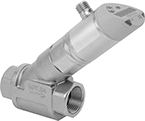 |
Variable Area Flow Measurement |
 |
Vortex Flow Measurement |
Send flow rate and temperature measurements simultaneously to a programmable logic controller (PLC), data logger, or other receiving device. Used to monitor status or control equipment, these transmitters, also known as transducers, convert measurements to an electrical signal that is interpreted by receiving devices. As flow or temperature increases, the output signal increases. For your receiving device to interpret the signal, you will need to calibrate it for the measurement range and output signal of the transmitter. They only give accurate readings within the rated measurement range. Mount them inline with your pipe system. They’ll measure flow correctly in any mounting orientation.
A digital display makes it easy to view readings and adjust settings at the source. To change settings and receive error messages remotely from your PLC or computer, program one of the outputs to use IO Link. You’ll need an IO Link controller (not included) to connect to your interface.
Variable Area Flow Measurement—Variable-area transmitters determine the flow rate by tracking where the liquid pushes the piston. They have two configurable outputs. One can be wired as an analog output or a digital switch. The other one can be wired as a digital switch, digital pulse output, or IO Link. Pulse outputs send flow data using spikes of voltage that match the input voltage of the transmitter. The higher the flow, the more pulses they send. These transmitters are calibrated with water, glycol solutions, and coolants but can be recalibrated in the field for other liquids.
Vortex Flow Measurement—Vortex transmitters determine the flow rate by measuring the size of the vortex created as liquid flows through them. They don’t have any moving parts that can break or get stuck. Use them only with liquids that are at least 95% water. They have one analog output for flow and another for temperature. The output for temperature can also be wired for IO Link.
Flow Measurement Type | Pipe Connections | Flow Range, gph | End-to-End Lg. | Accuracy | Max. Pressure @ Temp. | Temp. Range, ° F | Seal Material | Input Voltage Range, V DC | Mounting Position | Field Recalibratable | Enclosure Rating | Each | |||||||||||||||||||||||||||||||||||||||||||||||||||||||||||||||||||||||||||||||||||||||
|---|---|---|---|---|---|---|---|---|---|---|---|---|---|---|---|---|---|---|---|---|---|---|---|---|---|---|---|---|---|---|---|---|---|---|---|---|---|---|---|---|---|---|---|---|---|---|---|---|---|---|---|---|---|---|---|---|---|---|---|---|---|---|---|---|---|---|---|---|---|---|---|---|---|---|---|---|---|---|---|---|---|---|---|---|---|---|---|---|---|---|---|---|---|---|---|---|---|---|---|
One Digital Switch/Pulse Output and One 4-20 mA Analog Transmitter/Digital Switch Output—4-Pole Micro M12 Connection Plug | |||||||||||||||||||||||||||||||||||||||||||||||||||||||||||||||||||||||||||||||||||||||||||||||||||
316 Stainless Steel Body with 316 Stainless Steel Fitting | |||||||||||||||||||||||||||||||||||||||||||||||||||||||||||||||||||||||||||||||||||||||||||||||||||
| Variable Area | 3/4 NPT Female | 5 to 240 | 5 9/16" | -5% to 5% | 580 psi @ 70° F | 14 to 212 | Fluoroelastomer | 18 to 30 | Any Angle | Yes | IP65, IP67 | 0000000 | 0000000 | ||||||||||||||||||||||||||||||||||||||||||||||||||||||||||||||||||||||||||||||||||||||
| Variable Area | 3/4 NPT Female | 7 to 360 | 5 9/16" | -5% to 5% | 580 psi @ 70° F | 14 to 212 | Fluoroelastomer | 18 to 30 | Any Angle | Yes | IP65, IP67 | 0000000 | 000000 | ||||||||||||||||||||||||||||||||||||||||||||||||||||||||||||||||||||||||||||||||||||||
| Variable Area | 3/4 NPT Female | 10 to 600 | 5 9/16" | -5% to 5% | 580 psi @ 70° F | 14 to 212 | Fluoroelastomer | 18 to 30 | Any Angle | Yes | IP65, IP67 | 0000000 | 000000 | ||||||||||||||||||||||||||||||||||||||||||||||||||||||||||||||||||||||||||||||||||||||
| Variable Area | 1 NPT Female | 30 to 1,620 | 5 3/4" | -5% to 5% | 362 psi @ 70° F | 14 to 212 | Fluoroelastomer | 18 to 30 | Any Angle | Yes | IP65, IP67 | 0000000 | 000000 | ||||||||||||||||||||||||||||||||||||||||||||||||||||||||||||||||||||||||||||||||||||||
| Variable Area | 1 1/2 NPT Female | 60 to 3,000 | 6 3/16" | -5% to 5% | 362 psi @ 70° F | 14 to 212 | Fluoroelastomer | 18 to 30 | Any Angle | Yes | IP65, IP67 | 0000000 | 000000 | ||||||||||||||||||||||||||||||||||||||||||||||||||||||||||||||||||||||||||||||||||||||
Two 4-20 mA Analog Transmitter Outputs—4-Pole Micro M12 Connection Plugs | |||||||||||||||||||||||||||||||||||||||||||||||||||||||||||||||||||||||||||||||||||||||||||||||||||
316 Stainless Steel Body with 316 Stainless Steel Fitting | |||||||||||||||||||||||||||||||||||||||||||||||||||||||||||||||||||||||||||||||||||||||||||||||||||
| Vortex | 1/2 NPT Female | 16 to 317 | 4 11/16" | -2% to 2% | 172 psi @ 70° F | 14 to 190 | Fluoroelastomer | 18 to 30 | Any Angle | No | IP65, IP67 | 0000000 | 000000 | ||||||||||||||||||||||||||||||||||||||||||||||||||||||||||||||||||||||||||||||||||||||
| Vortex | 1/2 NPT Female | 32 to 634 | 4 11/16" | -2% to 2% | 172 psi @ 70° F | 14 to 190 | Fluoroelastomer | 18 to 30 | Any Angle | No | IP65, IP67 | 0000000 | 000000 | ||||||||||||||||||||||||||||||||||||||||||||||||||||||||||||||||||||||||||||||||||||||
| Vortex | 3/4 NPT Female | 80 to 1,585 | 5 15/32" | -2% to 2% | 172 psi @ 70° F | 14 to 190 | Fluoroelastomer | 18 to 30 | Any Angle | No | IP65, IP67 | 0000000 | 000000 | ||||||||||||||||||||||||||||||||||||||||||||||||||||||||||||||||||||||||||||||||||||||
Noncontact Flow Transmitters
 |
Using ultrasonic waves, these transmitters measure the flow rate of your liquid from outside your pipe. They're a good choice for applications where you need to retrofit your system or avoid liquid coming into contact with the transmitter. Also known as transducers, these transmitters convert measurements to an electrical pulse that can be interpreted by receiving devices, such as remote displays and programmable logic controllers (PLCs). The pulse outputs match the input voltage of the transmitter. The higher the flow, the more pulses they send. For your receiving device to interpret the signal, you will need to calibrate it for the measurement range and output signal of the transmitter. They only give accurate readings within the rated measurement range. Configure them for either a 4-20mA or digital pulse output when installing.
A digital display makes it easy to check flow rate and configure settings. Clamp these transmitters onto your pipe with the included mounting hardware and gel pads. They measure flow no matter the mounting orientation.
These transmitters are calibrated with water but can be used with other liquids and will generally measure accurately, even if they differ in viscosity and density. You can recalibrate them in the field for accurate readings on pipe and operating conditions.
Flow Range for Pipe Size, gpm | Input Voltage | ||||||||||||||||||||||||||||||||||||||||||||||||||||||||||||||||||||||||||||||||||||||||||||||||||
|---|---|---|---|---|---|---|---|---|---|---|---|---|---|---|---|---|---|---|---|---|---|---|---|---|---|---|---|---|---|---|---|---|---|---|---|---|---|---|---|---|---|---|---|---|---|---|---|---|---|---|---|---|---|---|---|---|---|---|---|---|---|---|---|---|---|---|---|---|---|---|---|---|---|---|---|---|---|---|---|---|---|---|---|---|---|---|---|---|---|---|---|---|---|---|---|---|---|---|---|
Flow Measurement Type | For Pipe Size | 3/4 | 2 | 4 | End-to-End Lg. | Accuracy | Temp. Range, ° F | Min., V DC | Max. | Mounting Position | Field Recalibratable | Enclosure Rating | Each | ||||||||||||||||||||||||||||||||||||||||||||||||||||||||||||||||||||||||||||||||||||||
One Digital Pulse Output and One 4-20 mA Analog Transmitter Output—Wire Lead Connection | |||||||||||||||||||||||||||||||||||||||||||||||||||||||||||||||||||||||||||||||||||||||||||||||||||
Polycarbonate Body | |||||||||||||||||||||||||||||||||||||||||||||||||||||||||||||||||||||||||||||||||||||||||||||||||||
| Ultrasonic | 3/4 to 4 | 0 to 45 | 0 to 320 | 0 to 1,285 | 9 3/4" | -3% to 3% | 32 to 185 | 12 | 24V AC/24V DC | Any Angle | Yes | IP54 | 0000000 | 000000000 | |||||||||||||||||||||||||||||||||||||||||||||||||||||||||||||||||||||||||||||||||||||
High-Accuracy Flow and Temperature Transmitters
 |
Also known as magmeters, these transmitters use a magnetic field to measure flow rate and temperature with high accuracy. Because they use a magnetic field, they only work with conductive liquids, such as water. These transmitters, also known as transducers, convert measurements to an electrical signal that can be interpreted by receiving devices, such as remote displays and programmable logic controllers (PLCs) to monitor flow or control equipment. For your receiving device to interpret the signal, you will need to calibrate it for the measurement range and output signal of the transmitter. As flow or temperature increases, the output signal increases. These transmitters have one analog output for flow and another for temperature. They only give accurate readings within the rated measurement range. A digital display makes it easy to view readings and adjust settings at the source. Mount these transmitters inline with your pipe system. They measure flow correctly in any mounting orientation.
These transmitters are calibrated with water. They can only be used with liquids with a conductivity of at least 20 µS/cm.
Flow Range | |||||||||||||||||||||||||||||||||||||||||||||||||||||||||||||||||||||||||||||||||||||||||||||||||||
|---|---|---|---|---|---|---|---|---|---|---|---|---|---|---|---|---|---|---|---|---|---|---|---|---|---|---|---|---|---|---|---|---|---|---|---|---|---|---|---|---|---|---|---|---|---|---|---|---|---|---|---|---|---|---|---|---|---|---|---|---|---|---|---|---|---|---|---|---|---|---|---|---|---|---|---|---|---|---|---|---|---|---|---|---|---|---|---|---|---|---|---|---|---|---|---|---|---|---|---|
Flow Measurement Type | Pipe Connections | Gallons per Minute, gpm | Liters per Minute, L/min | End-to-End Lg. | Accuracy | Max. Pressure @ Temp. | Temp. Range, ° F | Input Voltage Range, V DC | Mounting Position | Field Recalibratable | Enclosure Rating | Each | |||||||||||||||||||||||||||||||||||||||||||||||||||||||||||||||||||||||||||||||||||||||
Two 4-20 mA Analog Transmitter Outputs—4-Pole Micro M12 Connection Plugs | |||||||||||||||||||||||||||||||||||||||||||||||||||||||||||||||||||||||||||||||||||||||||||||||||||
316 Stainless Steel/Plastic/Polybutylene Body with 316 Stainless Steel Fitting | |||||||||||||||||||||||||||||||||||||||||||||||||||||||||||||||||||||||||||||||||||||||||||||||||||
| Magnetic Induction | 1/2 NPT Female | 0.03 to 6.6 | 0.1 to 25 | 2 1/8" | -2% to 2% | 225 psi @ 70° F | 0 to 175 | 20 to 30 | Any Angle | No | IP67 | 00000000 | 0000000 | ||||||||||||||||||||||||||||||||||||||||||||||||||||||||||||||||||||||||||||||||||||||
| Magnetic Induction | 3/4 NPT Female | 0.02 to 13.22 | 0.2 to 50 | 2 1/8" | -2% to 2% | 225 psi @ 70° F | 0 to 175 | 20 to 30 | Any Angle | No | IP67 | 00000000 | 000000 | ||||||||||||||||||||||||||||||||||||||||||||||||||||||||||||||||||||||||||||||||||||||
| Magnetic Induction | 1 NPT Female | 0.1 to 26.4 | 0.2 to 100 | 2 1/8" | -2% to 2% | 225 psi @ 70° F | 0 to 175 | 20 to 30 | Any Angle | No | IP67 | 00000000 | 00000000 | ||||||||||||||||||||||||||||||||||||||||||||||||||||||||||||||||||||||||||||||||||||||
| Magnetic Induction | 1 1/2 NPT Female | 1.3 to 79.3 | 5 to 300 | 6 11/16" | -0.8% to 0.8% | 225 psi @ 70° F | 0 to 175 | 20 to 30 | Any Angle | No | IP65, IP67 | 00000000 | 00000000 | ||||||||||||||||||||||||||||||||||||||||||||||||||||||||||||||||||||||||||||||||||||||
| Magnetic Induction | 2 NPT Female | 1.3 to 158.5 | 5 to 600 | 7 1/16" | -0.8% to 0.8% | 225 psi @ 70° F | 0 to 175 | 20 to 30 | Any Angle | No | IP65, IP67 | 00000000 | 00000000 | ||||||||||||||||||||||||||||||||||||||||||||||||||||||||||||||||||||||||||||||||||||||
Build-Your-Own Flanged Pipe Flow Transmitters
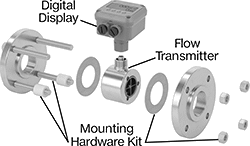 |
Components Sold Separately (Pipe Flanges Not Included) |
Install these transmitters between two flanges in a flanged pipe system to measure flow rate and send the data to a remote display or programmable logic controller (PLC). For easy cleaning and maintenance, you can slide the transmitter out from between the flanges. A complete transmitter consists of a flow transmitter, display, and mounting hardware kit (all components sold separately). Flowing liquid turns the turbine in the transmitter, while the easy-to-read display counts the number of turns to measure and transmit the flow. The display also shows total and batch flow volumes. Use these transmitters with clean, low-viscosity liquids to avoid clogging or other damage to the internal parts. Mount them inline with your pipe system. They’re accurate in any mounting orientation.
Also known as transducers, these transmitters help you monitor status or control equipment by converting measurements to a digital pulse that can be interpreted by receiving devices. Each pulse is a spike of voltage. The higher the flow, the more pulses they send. For your receiving device to interpret the signal from the transmitter, you will need to calibrate it for the measurement range and output signal of the transmitter. Transmitters will only provide accurate readings within the rated measurement range.
The transmitters are calibrated with water but can be used with other liquids.
Flow Transmitters
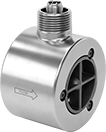 |
Flange | |||||||||||||||||||||||||||||||||||||||||||||||||||||||||||||||||||||||||||||||||||||||||||||||||||
|---|---|---|---|---|---|---|---|---|---|---|---|---|---|---|---|---|---|---|---|---|---|---|---|---|---|---|---|---|---|---|---|---|---|---|---|---|---|---|---|---|---|---|---|---|---|---|---|---|---|---|---|---|---|---|---|---|---|---|---|---|---|---|---|---|---|---|---|---|---|---|---|---|---|---|---|---|---|---|---|---|---|---|---|---|---|---|---|---|---|---|---|---|---|---|---|---|---|---|---|
Flow Measurement Type | Pipe Size | Flow Range, gpm | Bore Size | OD | Type | For Flange ANSI Class | End-to-End Lg. | Accuracy | Max. Pressure @ Temp. | Temp. Range, ° F | Mounting Position | Field Recalibratable | Pulse Frequency per Volume, pulse per gal. | Each | |||||||||||||||||||||||||||||||||||||||||||||||||||||||||||||||||||||||||||||||||||||
One Digital Pulse Output—2-Pin BNC Connection Plug | |||||||||||||||||||||||||||||||||||||||||||||||||||||||||||||||||||||||||||||||||||||||||||||||||||
316/316L Stainless Steel Body with 316/316L Stainless Steel Fitting | |||||||||||||||||||||||||||||||||||||||||||||||||||||||||||||||||||||||||||||||||||||||||||||||||||
| Turbine | 1 | 3 to 30 | 7/8" | 2" | Round | 150 | 4" | -1.0% to 1.0% | 285 psi @ 70° F | -150 to 350 | Any Angle | No | 3,100 | 0000000 | 0000000 | ||||||||||||||||||||||||||||||||||||||||||||||||||||||||||||||||||||||||||||||||||||
| Turbine | 2 | 5 to 50 | 1" | 3 5/8" | Round | 150 | 2 1/2" | -1.0% to 1.0% | 285 psi @ 70° F | -150 to 350 | Any Angle | No | 850 | 0000000 | 00000000 | ||||||||||||||||||||||||||||||||||||||||||||||||||||||||||||||||||||||||||||||||||||
| Turbine | 2 | 15 to 180 | 1 1/2" | 3 5/8" | Round | 150 | 2 1/2" | -1.0% to 1.0% | 285 psi @ 70° F | -150 to 350 | Any Angle | No | 325 | 0000000 | 00000000 | ||||||||||||||||||||||||||||||||||||||||||||||||||||||||||||||||||||||||||||||||||||
| Turbine | 3 | 60 to 600 | 3" | 5" | Round | 150 | 4 1/4" | -1.0% to 1.0% | 285 psi @ 70° F | -150 to 350 | Any Angle | No | 50 | 0000000 | 00000000 | ||||||||||||||||||||||||||||||||||||||||||||||||||||||||||||||||||||||||||||||||||||
Displays
 |
Display Type | Batteries Included | Each | |||
|---|---|---|---|---|---|
| Digital | Yes | 0000000 | 0000000 | ||
Ultra-Low-Flow Flow Transmitters
 |
Often used in low-flow metering applications for lubricants or antifreeze, these transmitters measure flow rate and send the data to a remote display or programmable logic controller (PLC). To measure flow, they have oval-shaped gears that move the liquid through the flowmeter—how fast the gears turn correspond to the flow rate. Also known as transducers, they help you monitor status or control equipment by converting measurements to an electrical pulse that can be interpreted by receiving devices. The higher the flow, the more pulses they send. Mount them inline with your pipe system. They’re accurate in any mounting orientation.
These transmitters are calibrated with oil but can be used with other liquids and will generally measure accurately, even if they differ in viscosity and density.
Flow Measurement Type | Pipe Connections | Flow Range, ml/min | Accuracy | Overall Ht. | Dia. | Max. Pressure @ Temp. | Temp. Range, ° F | Seal Material | Input Voltage Range, V DC | Mounting Position | Field Recalibratable | Pulse Frequency per Volume, pulse per ml | Each | ||||||||||||||||||||||||||||||||||||||||||||||||||||||||||||||||||||||||||||||||||||||
|---|---|---|---|---|---|---|---|---|---|---|---|---|---|---|---|---|---|---|---|---|---|---|---|---|---|---|---|---|---|---|---|---|---|---|---|---|---|---|---|---|---|---|---|---|---|---|---|---|---|---|---|---|---|---|---|---|---|---|---|---|---|---|---|---|---|---|---|---|---|---|---|---|---|---|---|---|---|---|---|---|---|---|---|---|---|---|---|---|---|---|---|---|---|---|---|---|---|---|---|
One Digital Pulse Output—Wire Lead Connection | |||||||||||||||||||||||||||||||||||||||||||||||||||||||||||||||||||||||||||||||||||||||||||||||||||
316 Stainless Steel Body | |||||||||||||||||||||||||||||||||||||||||||||||||||||||||||||||||||||||||||||||||||||||||||||||||||
| Positive Displacement | 1/8 NPT Female | 3 to 300 | -0.5% to 0.5% | 2 7/8" | 1 1/2" | 1,450 psi @ 70° F | -22 to 176 | Viton® Fluoroelastomer | 4 to 26 | Any Angle | No | 9 | 0000000 | 000000000 | |||||||||||||||||||||||||||||||||||||||||||||||||||||||||||||||||||||||||||||||||||||
| Positive Displacement | 1/8 NPT Female | 10 to 1,000 | -0.5% to 0.5% | 2 7/8" | 1 15/16" | 1,450 psi @ 70° F | -22 to 176 | Viton® Fluoroelastomer | 4 to 26 | Any Angle | No | 4 | 0000000 | 00000000 | |||||||||||||||||||||||||||||||||||||||||||||||||||||||||||||||||||||||||||||||||||||
Insertion-Mount Flow and Temperature Transmitters
 |
Thread mounting hardware (sold separately) into your pipe connection and insert the probe of these transmitters to measure the flow and temperature of water, oil, or air. The probe is held in place with a compression fitting on the other end of the mounting hardware. They’re often used in large-diameter pipes where it would be difficult to install a transmitter inline. To calculate the flow rate, these transmitters generate a small amount of heat, then measure the cooling effect your liquid or air has on it. They measure and output both flow and temperature, making them ideal for applications where temperature fluctuates. Also known as transducers, they convert measurements to an electrical signal that can be interpreted by receiving devices, such as remote displays and programmable logic controllers (PLCs) to monitor flow or control equipment. As flow or temperature increases, the output signal increases. For your receiving device to interpret the signal, you will need to calibrate it for the measurement range and output signal of the transmitter. They only give accurate readings within the rated measurement range. They’ll measure flow correctly in any mounting orientation. These transmitters are calibrated with air, glycol solutions, oil, and water but can be recalibrated in the field for other liquids.
Adjust settings at the source using the digital display. These transmitters have two configurable outputs. One can be wired for flow or temperature as an analog output or a digital switch. The other one can be wired for flow as a digital switch, digital pulse output, or IO Link. Pulse outputs send flow data using spikes of voltage that match the input voltage of the transmitter. The higher the flow, the more pulses they send. To change settings and receive error messages remotely from your PLC or computer, you can program one of the outputs to use IO Link. You’ll need an IO Link controller (not included) to connect to your interface.
Flow Measurement Type | Flow Range, gpm | Probe Lg. | End-to-End Lg. | Accuracy | Max. Pressure @ Temp. | Temp. Range, ° F | Input Voltage Range, V DC | Mounting Position | Field Recalibratable | Enclosure Rating | Each | ||||||||||||||||||||||||||||||||||||||||||||||||||||||||||||||||||||||||||||||||||||||||
|---|---|---|---|---|---|---|---|---|---|---|---|---|---|---|---|---|---|---|---|---|---|---|---|---|---|---|---|---|---|---|---|---|---|---|---|---|---|---|---|---|---|---|---|---|---|---|---|---|---|---|---|---|---|---|---|---|---|---|---|---|---|---|---|---|---|---|---|---|---|---|---|---|---|---|---|---|---|---|---|---|---|---|---|---|---|---|---|---|---|---|---|---|---|---|---|---|---|---|---|
One Digital Switch/Pulse Output and One 4-20 mA Analog Transmitter/Digital Switch/Pulse Output—4-Pole Micro M12 Connection Plug | |||||||||||||||||||||||||||||||||||||||||||||||||||||||||||||||||||||||||||||||||||||||||||||||||||
316 Stainless Steel/Polybutylene Body with 316 Stainless Steel Fitting | |||||||||||||||||||||||||||||||||||||||||||||||||||||||||||||||||||||||||||||||||||||||||||||||||||
| Thermal | 0.02 to 12 | 3 15/16" | 7 9/16" | -10% to 10% | 725 psi @ 212° F | 0 to 212 | 18 to 30 | Any Angle | Yes | IP65, IP67 | 00000000 | 0000000 | |||||||||||||||||||||||||||||||||||||||||||||||||||||||||||||||||||||||||||||||||||||||
| Thermal | 0.02 to 12 | 7 7/8" | 11 1/2" | -10% to 10% | 725 psi @ 212° F | 0 to 212 | 18 to 30 | Any Angle | Yes | IP65, IP67 | 00000000 | 000000 | |||||||||||||||||||||||||||||||||||||||||||||||||||||||||||||||||||||||||||||||||||||||
Compression Tube Flow Transmitters for Gases
 |
Commonly referred to as thermal mass flowmeters, these transmitters calculate flow rate by measuring how much they cool as air and other gases pass through them. This means they’re accurate even if there are temperature and pressure changes, unlike most other transmitters. Used to monitor flow or control equipment, these transmitters, also known as transducers, convert measurements to an electrical signal that is interpreted by receiving devices. As flow increases, the output signal increases. For your receiving device to interpret the signal, you will need to calibrate it for the measurement range and output signal of the transmitter. They only give accurate readings within the rated measurement range. A digital display makes it easy to check the flow rate and adjust settings. Mount these transmitters inline with your system.
These transmitters are calibrated with air. You can use them with other gases, but they will not be as accurate.
Voltage Adapters—Voltage adapters are required to connect these transmitters to a power source.
Flow Transmitters | Voltage Adapters | ||||||||||||||||||||||||||||||||||||||||||||||||||||||||||||||||||||||||||||||||||||||||||||||||||
|---|---|---|---|---|---|---|---|---|---|---|---|---|---|---|---|---|---|---|---|---|---|---|---|---|---|---|---|---|---|---|---|---|---|---|---|---|---|---|---|---|---|---|---|---|---|---|---|---|---|---|---|---|---|---|---|---|---|---|---|---|---|---|---|---|---|---|---|---|---|---|---|---|---|---|---|---|---|---|---|---|---|---|---|---|---|---|---|---|---|---|---|---|---|---|---|---|---|---|---|
For Tube OD | Flow Range, L/min | End-to-End Lg. | Accuracy | Max. Pressure @ Temp. | Temp. Range, ° F | Seal Material | Input Voltage Range, V DC | Mounting Position | Each | Each | |||||||||||||||||||||||||||||||||||||||||||||||||||||||||||||||||||||||||||||||||||||||||
One 4-20 mA Analog Transmitter Output—2.1 mm Plug End ID Barrel Connection/DB9 Connection Plug | |||||||||||||||||||||||||||||||||||||||||||||||||||||||||||||||||||||||||||||||||||||||||||||||||||
Aluminum Body with Brass Fitting | |||||||||||||||||||||||||||||||||||||||||||||||||||||||||||||||||||||||||||||||||||||||||||||||||||
| 1/4" | 0 to 0.01 | 5 1/8" | -1.0% to 1.0% | 1,000 psi @ 70° F | 32 to 122 | Viton® Fluoroelastomer | 12 to 26 | Horizontal | 0000000 | 0000000 | 00000000 | 00000 | |||||||||||||||||||||||||||||||||||||||||||||||||||||||||||||||||||||||||||||||||||||||
| 1/4" | 0 to 0.05 | 5 1/8" | -1.0% to 1.0% | 1,000 psi @ 70° F | 32 to 122 | Viton® Fluoroelastomer | 12 to 26 | Horizontal | 0000000 | 000000 | 00000000 | 0000 | |||||||||||||||||||||||||||||||||||||||||||||||||||||||||||||||||||||||||||||||||||||||
| 1/4" | 0 to 0.1 | 5 1/8" | -1.0% to 1.0% | 1,000 psi @ 70° F | 32 to 122 | Viton® Fluoroelastomer | 12 to 26 | Horizontal | 0000000 | 000000 | 00000000 | 0000 | |||||||||||||||||||||||||||||||||||||||||||||||||||||||||||||||||||||||||||||||||||||||
| 1/4" | 0 to 0.5 | 5 1/8" | -1.0% to 1.0% | 1,000 psi @ 70° F | 32 to 122 | Viton® Fluoroelastomer | 12 to 26 | Horizontal | 0000000 | 000000 | 00000000 | 0000 | |||||||||||||||||||||||||||||||||||||||||||||||||||||||||||||||||||||||||||||||||||||||
| 1/4" | 0 to 1 | 5 1/8" | -1.0% to 1.0% | 1,000 psi @ 70° F | 32 to 122 | Viton® Fluoroelastomer | 12 to 26 | Horizontal | 0000000 | 000000 | 00000000 | 0000 | |||||||||||||||||||||||||||||||||||||||||||||||||||||||||||||||||||||||||||||||||||||||
| 1/4" | 0 to 5 | 5 1/8" | -1.0% to 1.0% | 1,000 psi @ 70° F | 32 to 122 | Viton® Fluoroelastomer | 12 to 26 | Horizontal | 0000000 | 000000 | 00000000 | 0000 | |||||||||||||||||||||||||||||||||||||||||||||||||||||||||||||||||||||||||||||||||||||||
| 1/4" | 0 to 10 | 5 1/8" | -1.0% to 1.0% | 1,000 psi @ 70° F | 32 to 122 | Viton® Fluoroelastomer | 12 to 26 | Horizontal | 0000000 | 000000 | 00000000 | 0000 | |||||||||||||||||||||||||||||||||||||||||||||||||||||||||||||||||||||||||||||||||||||||
| 1/4" | 0 to 50 | 6 3/16" | -1.0% to 1.0% | 1,000 psi @ 70° F | 32 to 122 | Viton® Fluoroelastomer | 12 to 26 | Horizontal | 0000000 | 00000000 | 00000000 | 0000 | |||||||||||||||||||||||||||||||||||||||||||||||||||||||||||||||||||||||||||||||||||||||
| 3/8" | 0 to 100 | 6 1/4" | -1.0% to 1.0% | 1,000 psi @ 70° F | 32 to 122 | Viton® Fluoroelastomer | 12 to 26 | Horizontal | 0000000 | 00000000 | 00000000 | 0000 | |||||||||||||||||||||||||||||||||||||||||||||||||||||||||||||||||||||||||||||||||||||||
Flow, Pressure, and Temperature Transmitters for Gases
 |
Measure and transmit flow rate, pressure, and temperature of industrial gases, such as air, argon, CO2, and nitrogen, flowing through your system. These transmitters are ideal for applications where temperature and pressure can fluctuate. To calculate flow rate, they generate a small amount of heat, then measure the cooling effect your gas has on it. Also known as transducers, these transmitters convert measurements to an electrical signal that can be interpreted by receiving devices, such as remote displays and programmable logic controllers (PLCs). As flow, temperature, and pressure increases, the output signal increases. For your receiving device to interpret the signal, you will need to calibrate it for the measurement range and output signal of the transmitter. They only give accurate readings within the rated measurement range. Mount them directly inline with your system. They measure correctly no matter their mounting orientation.
A digital display makes it easy to read measurements and adjust settings based on your gas. These transmitters have two configurable outputs, and each output can only be wired for one measurement (flow rate, pressure, or temperature). Outputs configured as digital pulse send flow data using spikes of voltage that match the input voltage of the transmitter. One of the outputs can be wired for IO-Link, so you can change settings and receive error messages remotely from your PLC or computer. You’ll need an IO Link controller (not included) to connect to your interface.
These transmitters are calibrated with air but still measure accurately when used with other gases.
Flow Measurement Type | Pipe Connections | Flow Range, scfm | End-to-End Lg. | Accuracy | Max. Pressure @ Temp. | Temp. Range, ° F | Seal Material | Input Voltage Range, V DC | Mounting Position | Field Recalibratable | Enclosure Rating | Each | |||||||||||||||||||||||||||||||||||||||||||||||||||||||||||||||||||||||||||||||||||||||
|---|---|---|---|---|---|---|---|---|---|---|---|---|---|---|---|---|---|---|---|---|---|---|---|---|---|---|---|---|---|---|---|---|---|---|---|---|---|---|---|---|---|---|---|---|---|---|---|---|---|---|---|---|---|---|---|---|---|---|---|---|---|---|---|---|---|---|---|---|---|---|---|---|---|---|---|---|---|---|---|---|---|---|---|---|---|---|---|---|---|---|---|---|---|---|---|---|---|---|---|
One Digital Switch/Pulse Output and One 4-20 mA Analog Transmitter/Digital Switch/Pulse Output—4-Pole Micro M12 Connection Plug | |||||||||||||||||||||||||||||||||||||||||||||||||||||||||||||||||||||||||||||||||||||||||||||||||||
304 Stainless Steel Body with 304 Stainless Steel Fitting | |||||||||||||||||||||||||||||||||||||||||||||||||||||||||||||||||||||||||||||||||||||||||||||||||||
| Thermal | 1/2 NPT Male | 0.15 to 44 | 11 13/16" | -6% to 6% | 230 psi @ 70° F | 14 to 140 | Fluoroelastomer | 18 to 30 | Any Angle | No | IP65, IP67 | 0000000 | 0000000 | ||||||||||||||||||||||||||||||||||||||||||||||||||||||||||||||||||||||||||||||||||||||
| Thermal | 1 NPT Male | 0.4 to 132 | 18 3/4" | -6% to 6% | 230 psi @ 70° F | 14 to 140 | Fluoroelastomer | 18 to 30 | Any Angle | No | IP65, IP67 | 0000000 | 00000000 | ||||||||||||||||||||||||||||||||||||||||||||||||||||||||||||||||||||||||||||||||||||||
